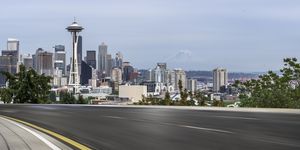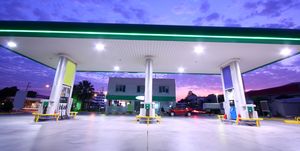- We all know that the COVID-19 pandemic has cut traffic, but it’s surprising just how much it has changed major corridors.
- For instance, average speeds in Los Angeles are 48 percent higher because there’s so much less traffic on the roads.
- Surprisingly, air traffic is only down 7 percent nationwide—for now.
The novel coronavirus, COVID-19, is wreaking horrifying havoc on every aspect of our interconnected world. Its impact has been particularly notable in the transportation sector.
Many people have been made aware of the shift in commercial air traffic. As of March 15, the number of flights has fallen by more than 7 percent compared to the same time period in 2019, and greater declines are expected as international travel bans continue to go into effect. But ground transportation has seen far more drastic effects.
New York City, which features the nation’s lowest incidence of car ownership and the current highest number of COVID-19 cases, has (as of March 12) seen subway, commuter train, and bus ridership decline massively, with double-digit drops. According to the Metropolitan Transit Authority (MTA), which runs most of the region’s public transit, this includes a decline in use of the New York City Subway by nearly 20 percent, the Long Island Railroad by over 30 percent and the Metro North commuter railroad by nearly 50 percent, when compared to the same day a year ago.
“Not surprisingly, we are seeing daily declines in ridership, and we expect those declines to continue as mass gatherings are barred and major companies and universities move to telecommuting,” said Abbey Collins, the MTA chief communications officer. The MTA continues to run regular service.
New Yorkers are not necessarily fleeing into their cars. Because of the shuttering of so many businesses, mandatory work-from-home policies, and shelter-in-place orders, automobile usage in the city has also markedly diminished. According to INRIX, a Seattle-based firm that analyzes real-time traffic information derived from anonymous in-car and smartphone data, on March 18, speeds on the highways surrounding New York City were more than 50 percent higher during the morning commute, and nearly 60 percent higher in the evening commute, than the average of same-day-of-week trips during the past three or four months.
“We are not counting cars. We’re taking a sample of the speed the cars are going through those segments,” said Trevor Reed, transportation analyst for INRIX. “But in this scenario, higher speeds correspond to fewer cars.”
Similar patterns have emerged on the West Coast. Seattle, which was the first major U.S. city to implement severe restrictions in response to COVID-19, has seen shocking changes in traffic. According to INRIX, on the key I-5 corridor, heading north-south into and out of downtown, traffic on March 18 was moving at speeds 100 percent faster than typical during the morning and afternoon commutes. Los Angeles, which is infamous for its traffic, has seen dramatic changes as well, with average speeds increasing on an average of 48 percent following Gov. Gavin Newsom’s shelter-at-home order.
“Los Angeles initially was a bit more delayed, but in the last day or so, things have started to pick up there,” said Reed. “We’re seeing the biggest speed increases occur where government has really acted to constrain movement, so Seattle was the first, then San Francisco, and then the northeast, Boston and New York, Chicago, all saw that precipitous increase earlier, but now you’re really seeing dramatic increases across the board, Los Angeles included at this point.”
INRIX can also analyze trips to specific locales—though the analysts emphasize that this data is scrubbed of all personal information. It has noted that, since March 11, visits to downtown Seattle have dropped by nearly 40 percent, while visits to big-box stores have increased significantly, as people stocked up on supplies. Visits to malls and supermarkets—where the crowds are denser—have decreased during this same time.
City Traffic May Change for Good
As more major cities adopt similar, or even more intensive, restrictions to combat the virus, the shifts in commuting, traffic, and consumer behavior could cause major changes to the urban infrastructure. New York City’s MTA, the budget for which relies heavily on user fares and tolls paid on automotive bridge and tunnel crossings, has announced a $4 billion deficit. And urban cores, which rely on a steady stream of humans to support their vital street life, could falter.
But there are also valuable lessons to be learned for dealing with the scourge of vehicular congestion. According to Reed, American commutes only account for 15 percent of all trips, so removing just 5 or 10 percent of those trips to the most constrained areas can have a major effect. “Where it might have the biggest impact is just how responsive, how flexible, people’s commute patterns can be if they really put the pressure on,” Reed said. “There’s an acknowledgement in the data that commute patterns and people driving are a really responsive ecosystem, and you can manage it in different ways for different outcomes.”
Source: Motor - aranddriver.com




